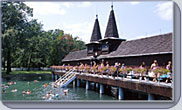 |
 |
 |
 |
 |
 |
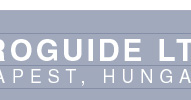 |
 |
|
| PROGRAMS |
| Budapest sightseeing tour |
|
Photos>> 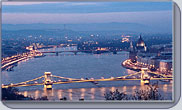 Budapest
is the capital of Hungary, with almost two million inhabitants,
centre of administration, industry, trade, transport and traffic,
education, culture, arts and sports. It is situated on both banks
of the river Danube: called Buda and Pest. There are nine bridges
over the Danube. Of the capital cities of the world Budapest is
the richest in baths. Budapest
is the capital of Hungary, with almost two million inhabitants,
centre of administration, industry, trade, transport and traffic,
education, culture, arts and sports. It is situated on both banks
of the river Danube: called Buda and Pest. There are nine bridges
over the Danube. Of the capital cities of the world Budapest is
the richest in baths. The most important sights of Budapest: The castle area on the Buda side: after the withdrawal of the Mongolian invaders in 1242, the Castle Hill was settled. During the centuries the castle was several times destroyed and rebuilt, the last reconstruction work was after the Second World War. Today it is the most significant centre of Budapest housing the Budapest History Museum, the Hungarian National Gallery, a section of the Hungarian National Museum, the Museum of Contemporary History and the National Széchenyi Library. Still on the Buda bank of the Danube can be visited the Gellért Hill, which offers a fine view, the Citadel and the statue of liberty. At the foot of the hill many mineral springs can be found, which supply Budapest with an amazing 70 million litres mineral water a day. One of the most famous baths is the Gellért bath. On the other side of the river, in Pest is the Saint Stephen’s Basilica, which is the biggest catholic church in Budapest. The Synagogue is the biggest one in the world with a Jewish Museum, built up in romantic and Byzantine Moorish style with 3000 seats. For the millennium of Hungary in 1896 the first underground railway was opened in mainland Europe under Andrássy Avenue, lined with elegant, multi-storey buildings. The Monument of the Millennium of Hungary, with statues of eminent Hungarians, is on the Heroes’ Square closing the outer end of the Avenue. On both side of the square can be found museum: the Art Gallery and the Museum of Fine Arts. The square is actually the entrance to City Park, with the nearby Castle of Vajdahunyad, which is a presentation of details of architectural monuments and illustration of styles of the historic Hungary. In the City Park can be also visited the Zoological and Botanical Garden, the most famous restaurant, the Gundel, The Fun Fair and the Széchenyi Bath. For a thousand year the Hungarian National Assembly had no permanent seat. The idea of a permanent building came at the beginning of the 19th century, but because of the unsettled political life construction could start only at the end of the century according to plans by Imre Steindl. |
| Cruise on the Danube |
Photos>> 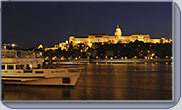 Cruise
on the Danube with lunch or dinner In the evenings it is the most
popular programme buffet dinner cruise with gipsy orchstra in the
illuminated Budapest Cruise
on the Danube with lunch or dinner In the evenings it is the most
popular programme buffet dinner cruise with gipsy orchstra in the
illuminated Budapest |
| Danube-Bend |
| Photos>>  There
are a large number of programs in Hungary and in the neighbouring
countries we offer to our partners.
Here are a few from the most popular ones: Danube Bend excursion
to Visegrad, Esztergom,
Szentendre, with medieval show. There
are a large number of programs in Hungary and in the neighbouring
countries we offer to our partners.
Here are a few from the most popular ones: Danube Bend excursion
to Visegrad, Esztergom,
Szentendre, with medieval show. |
| Puszta tour |
Photos>> 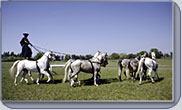 Puszta
tour to the great Hungarian plain field with horse-show and lunch
or dinner with traditional Hungarian wines Unique show the puszta
10 in one hand ! Puszta
tour to the great Hungarian plain field with horse-show and lunch
or dinner with traditional Hungarian wines Unique show the puszta
10 in one hand ! |
| Eastern
Hungary Gödöllõ |
|
Photos>> 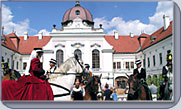 The
former Grassalkovics Palace, later a state royal summer residence,
is one of the most outstanding examples of rural baroque architecture
in Hungary. Starting from Maria Theresa other members of the House
of Habsburgs and Queen Elizabeth stayed here too. In the park of
the palace a Calvary in baroque style was built in 1771. The Holy
Virgin column in baroque style is a municipal monument. Exhibition
places include: collections of tractor and plough history and of
local history. With its Agricultural University Gödöllo
is a major scientific centre. The
former Grassalkovics Palace, later a state royal summer residence,
is one of the most outstanding examples of rural baroque architecture
in Hungary. Starting from Maria Theresa other members of the House
of Habsburgs and Queen Elizabeth stayed here too. In the park of
the palace a Calvary in baroque style was built in 1771. The Holy
Virgin column in baroque style is a municipal monument. Exhibition
places include: collections of tractor and plough history and of
local history. With its Agricultural University Gödöllo
is a major scientific centre. |
| Eger |
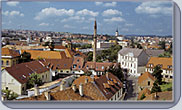 Eger
is the town of county rank, the western gate of the Bükk Mountains.
County seat and archbishop’s residence, rich in historical monuments
and cultural sights, a centre of education. International town of
vineyards and wine, centre of viticulture in the region. Secular
sights include the medieval castle with casemates housing István
Dobó Castle Museum. Turkish minaret of the 17th century,
the furthest one to the north in Europe. There are a large number
of residential houses in Baroque style. Ecclesiastical monuments
include the neoclassical Cathedral, the baroque and rococo Cistercian
church, the baroque archbishop’s palace, the Franciscan monastery
and church, the Minorite church and monastery and the Greek Orthodox
church. Eger
is the town of county rank, the western gate of the Bükk Mountains.
County seat and archbishop’s residence, rich in historical monuments
and cultural sights, a centre of education. International town of
vineyards and wine, centre of viticulture in the region. Secular
sights include the medieval castle with casemates housing István
Dobó Castle Museum. Turkish minaret of the 17th century,
the furthest one to the north in Europe. There are a large number
of residential houses in Baroque style. Ecclesiastical monuments
include the neoclassical Cathedral, the baroque and rococo Cistercian
church, the baroque archbishop’s palace, the Franciscan monastery
and church, the Minorite church and monastery and the Greek Orthodox
church. |
| Szilvásvárad |
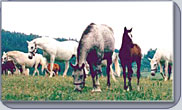 The
village is the most popular holiday village at the north-western
foot the Bükk Mountains. Its Calvinist church was built according
to plans by József Hild in neo-classical style. The former
Pallavicini mansion was built on 1860. Walking upstream along the
streamlet Szalajka the trout-pools with breeding establishments,
the Open-air Museum of Forestry, the Veil cascade and the primitive
man’s cave on hill Istállósko can be visited. Further
sights in the village include a riding hall, the Lipizzan stud and
the exhibition of the History of Horse-Breeding. The
village is the most popular holiday village at the north-western
foot the Bükk Mountains. Its Calvinist church was built according
to plans by József Hild in neo-classical style. The former
Pallavicini mansion was built on 1860. Walking upstream along the
streamlet Szalajka the trout-pools with breeding establishments,
the Open-air Museum of Forestry, the Veil cascade and the primitive
man’s cave on hill Istállósko can be visited. Further
sights in the village include a riding hall, the Lipizzan stud and
the exhibition of the History of Horse-Breeding. |
| Tokaj |
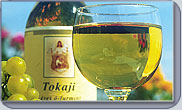 The
town is at the confluence of the rivers Tisza and Bodrog. Eponym
of the world-famous wine-district. The fortress built at the confluence
of the rivers is reduced to ruins. The Rákóczi-Dessewfy
mansion is one of the finest edifices in Tokaj. Exhibitions include
the Tokaj Museum with remarkable collections of church history and
the arts of addition to that of viticulture, Cellar Museum and Winepress-shed
Museum with collections of wien culture. In Tokaj can be found the
best grapes in Hungary that is reason why the wine of Tokaj is world
famous. The
town is at the confluence of the rivers Tisza and Bodrog. Eponym
of the world-famous wine-district. The fortress built at the confluence
of the rivers is reduced to ruins. The Rákóczi-Dessewfy
mansion is one of the finest edifices in Tokaj. Exhibitions include
the Tokaj Museum with remarkable collections of church history and
the arts of addition to that of viticulture, Cellar Museum and Winepress-shed
Museum with collections of wien culture. In Tokaj can be found the
best grapes in Hungary that is reason why the wine of Tokaj is world
famous. |
| Hollókõ |
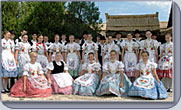 The
village is part of the world’s cultural and natural heritage. This
award was conferred by UNESCO in 1987 to the village. It is a tiny
dead-end community famous for its traditional architecture, costumes
and fine local dialect. Village preserve comprising 55 houses in
a scenic natural environment. In the middle, the medieval church
has been preserved, covered with wooden shingles. Inhabitants are
palóc, a remarkable group in Hungary’s population. Costumes
are a motley of colours. Village museum with painted furniture and
tools, weaver houses are memories of past everyday life. The
village is part of the world’s cultural and natural heritage. This
award was conferred by UNESCO in 1987 to the village. It is a tiny
dead-end community famous for its traditional architecture, costumes
and fine local dialect. Village preserve comprising 55 houses in
a scenic natural environment. In the middle, the medieval church
has been preserved, covered with wooden shingles. Inhabitants are
palóc, a remarkable group in Hungary’s population. Costumes
are a motley of colours. Village museum with painted furniture and
tools, weaver houses are memories of past everyday life. |
| Western
Hungary Sopron |
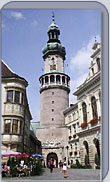 Sopron
is the city of faithfulness. During the country planning after the
first world war the citizens of Sopron were able to decide: they
would like to belong to Austria or to Hungary. They held a plebiscite,
and as a result of this Sopron belongs to Hungary since then. In
memory of this event today a sculptural group can be seen. Sopron
is the city of faithfulness. During the country planning after the
first world war the citizens of Sopron were able to decide: they
would like to belong to Austria or to Hungary. They held a plebiscite,
and as a result of this Sopron belongs to Hungary since then. In
memory of this event today a sculptural group can be seen. The centre of the city offers many sights. Through a fire-watch tower can be entered the city centre then you can visit the so called Kecsketemplom (“goat church”), the Bezerédj House, which is one of the finest baroque palace in Sopron and the Roman Catholic Religious Art Collection. Because in the middle ages Jewish merchants lived in the city, today two synagogues can be visited here. |
| Kõszeg |
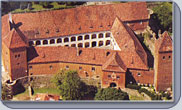 The
city is famous about the victory over the Turks in 1532. The castle
was guarded by Jurisics and in memory of this victory was established
the Jurisics Miklós Castle Museum. In this area also a Castle
Theatre can be found. At the main square of the city (Jurisics square)
were built up the Tower of the Heroes, the protestant Saint Emeric
Church, the church of Saint Jakab apostle and the Holy Trinity statue
(in memory for those people who died in plague). The
city is famous about the victory over the Turks in 1532. The castle
was guarded by Jurisics and in memory of this victory was established
the Jurisics Miklós Castle Museum. In this area also a Castle
Theatre can be found. At the main square of the city (Jurisics square)
were built up the Tower of the Heroes, the protestant Saint Emeric
Church, the church of Saint Jakab apostle and the Holy Trinity statue
(in memory for those people who died in plague). |
| Szombathely |
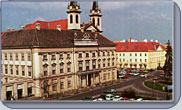 Szombathely
is the city where material remains from the prehistoric age went
down to posterity. Here can be seen the refurbished amber road,
which already covered in this territory in the Roman period (the
Roman city was established by a Roman Cesar in A.D. 50). The city
offers the following sights: the baroque Episcopal Palace, the Diocesan
Library and Archives, Iseum, the Roman Catholic Parish Church. In
Szombathely every year take place cultural programs: the Spring
Festival, the Savaria International Dance Competition, the Iseum
Open-air Games. Szombathely
is the city where material remains from the prehistoric age went
down to posterity. Here can be seen the refurbished amber road,
which already covered in this territory in the Roman period (the
Roman city was established by a Roman Cesar in A.D. 50). The city
offers the following sights: the baroque Episcopal Palace, the Diocesan
Library and Archives, Iseum, the Roman Catholic Parish Church. In
Szombathely every year take place cultural programs: the Spring
Festival, the Savaria International Dance Competition, the Iseum
Open-air Games. |
| Herend |
|
Photos>>  Here
the first pieces of Herend Porcelain were made in the early 19th
century. Its appearance has changed little since the 1840s. The
present Herend Porcelain Museum opened in 1964 after restoration
of the building. The museum that opened in 1964 was both the collection
of a firm and a specialist museum for the porcelain industry. Here
the first pieces of Herend Porcelain were made in the early 19th
century. Its appearance has changed little since the 1840s. The
present Herend Porcelain Museum opened in 1964 after restoration
of the building. The museum that opened in 1964 was both the collection
of a firm and a specialist museum for the porcelain industry.The permanent exhibition presented highlights from the history of the manufactory and displayed popular and lesser-known forms and patterns, picking out some items that excelled for their size and technique or other characteristics. The porcelain of Herend is world famous and it attracts many visitors from all over the world. Visitors entering the Herend Porcelain Museum can be sure of receiving a full, colourful, varied and authentic picture of porcelain making at Herend over almost two centuries. |
| Keszthely |
| Photos>> 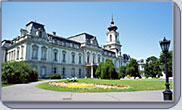 The
reputation of Keszthely was established by the Festetics family
and the Georgikon. The
reputation of Keszthely was established by the Festetics family
and the Georgikon. The most popular spot in the city is the baroque Festetics Palace. It consists of 101 rooms, it has a valuable onion shape cupola tower, a chapel and a library of 86 thousands books. Today it houses temporary exhibitions and concerts every week. Not far from the palace can be visited the Marzipan Museum. The Georgikon was founded by György Festetics and it was the first agricultural university in the country. The so called Balaton Museum introduces the emergence of the Lake Balaton and its flora and fauna. |
| Hévíz |
